Poverty and Income Inequality in Scotland 2010/11
This National Statistics publication presents annual estimates for the proportion and number of children, working age adults and pensioners living in low income households in Scotland. The estimates are used to measure progress towards UK and Scottish Government targets to reduce poverty and income inequality.
This document is part of a collection
Chapter 2: Poverty
Low-Income Poverty Indicators
The Scottish Government currently uses two main indicators of low-income poverty, both of which reveal slightly different information about changes in poverty over time. These indicators are relative and absolute poverty:
Relative poverty:
Individuals living in households whose equivalised income is below 60% of UK median income in the same year. This is a measure of whether those in the lowest income households are keeping pace with the growth of incomes in the population as a whole. In 2010/11 the relative poverty threshold for a couple with no children was an income of £251 per week (BHC) from all sources (see Annex 2 for further information on income definitions). For a couple with children the threshold would be higher and for a single person (without children) the threshold would be lower.
Absolute poverty:
Individuals living in households whose equivalised income is below 60% of the (inflation adjusted) median income in 1998/99. This is a measure of whether those in the lowest income households are seeing their incomes rise in real terms. In 2010/11 the absolute poverty threshold for a couple with no children was an income of £220 per week (BHC) from all sources (see Annex 2 for further information on income definitions).
The Scottish Government's National Indicator 35 is to "decrease the proportion of individuals living in poverty". This is measured using relative poverty before housing costs. Charts 1a and 1b below show Scottish trends for relative and absolute poverty between 1998/99 and 2010/11.
Chart 1a: Relative Poverty: 1998/99 - 2010/11
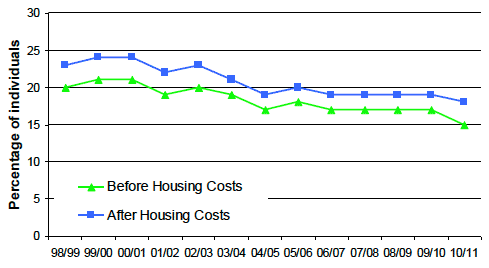
Chart 1b: Absolute Poverty: 1998/99 - 2010/11
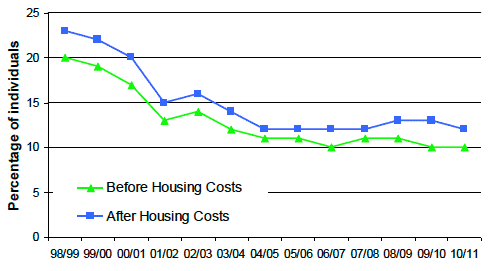
Source: HBAI dataset, DWP. See Annex 1 (Tables A1 and A2) for the figures behind these charts.
Charts with confidence intervals for relative and absolute poverty can be found in Confidence Intervals Surrounding Key Poverty Estimates
Note that the poverty estimates for 2008/09 and 2009/10 have been revised from the previous year's publication "Poverty and income inequality in Scotland: 2009/10". This is due to a slight revision to the UK dataset due to changes in the direct tax system in Northern Ireland and new tenure data from CLG.
Main points:
- In 2010/11 there were 780, 000 people (15 per cent of the population) in relative poverty (BHC) and 490, 000 people (10 per cent of the population) in absolute poverty (BHC) in Scotland.
- Relative poverty (BHC) has fallen by a statistically significant amount in a single year period for the first time since between 2003/04 and 2004/05 from 17 per cent in 2009/10 to 15 per cent in 2010/11, a reduction of 90,000 individuals.
- The following factors have influenced the reduction in relative poverty in 2010/11:
- Median equivalised household income decreased in real terms (down from £439 to £416 in 2010/11), which in turn decreased the relative poverty thresholds.
- Individual earnings fell in real terms in 2010/11 and this was one of the main factors in the reduction in median incomes.
- Benefit and tax credit income grew in cash terms and fell only slightly in real terms. This meant that low-income benefit-dependent households saw their income fall less in 2010/11 than households at the median, tending to decrease the overall rate of relative poverty, Before and After Housing Costs
- Between 2009/10 and 2010/11, the proportion of people in absolute poverty (BHC) remained around 10 per cent. There has been very little change in absolute poverty since 2004/05. There was a small reduction in absolute poverty (AHC) to 12 per cent, but this change is not statistically significant.
- For a reduction in the number of individuals living in households in absolute poverty over the period, incomes at the lower end of the income distribution in 2010/11 would have had to increase by more than inflation. Instead, household incomes of low-income households increased by about the same level as inflation, meaning there was no statistically significant change in absolute poverty levels in 2010/11.
- Between 2002/03 and 2004/05 relative and absolute poverty rates fell in Scotland, with absolute poverty falling more steeply. The poverty rates remained broadly the same between 2004/05 and 2009/10.
2.2 Child poverty
Child poverty is commonly measured using the following indicators:
- relative poverty,
- absolute poverty,
- material deprivation and low income combined.
These are three of the four poverty indicators which the UK parliament is required to report on by the 2010 Child Poverty Act. There is also a persistent poverty indicator in the Act but the precise target is yet to be defined. Information on the targets for the Child Poverty Act can be found in Annex 1.
The Scottish Government's National Indicator 36 is to "reduce children's deprivation". This is measured using the material deprivation and low-income combined poverty indicator.
Material Deprivation and Low-Income Combined Poverty Indicator:
Material deprivation is calculated from a suite of questions in the Family Resources Survey about whether people can afford to buy certain items and participate in leisure or social activities. This measure is applied to households with incomes below 70% of median income to create the 'material deprivation and low income combined' indicator. This indicator aims to provide a measure of children's living standards which, unlike relative and absolute poverty, is not solely based on income. For more detail about this indicator see Annex 2.
Chart 2 below presents recent Scottish poverty trends for these three child poverty indicators.
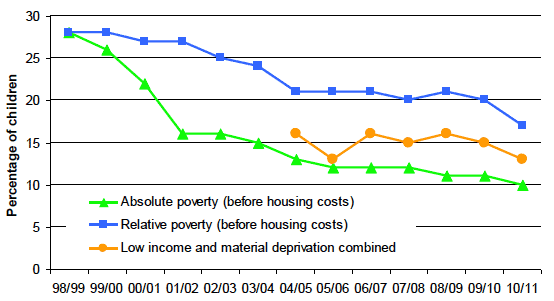
Source: HBAI dataset, DWP. See Annex 1 (Tables A1, A2 and A3) for the figures behind these charts.
Note: A version of this chart showing the Child Poverty Act targets can be found in Annex 1, Charts A8 and A9. Charts with confidence intervals for relative and absolute child poverty can be found in Confidence Intervals Surrounding Key Poverty Estimates.
Note that the poverty estimates for 2008/09 and 2009/10 have been revised from the previous year's publication "Poverty and income inequality in Scotland: 2009/10". This is due to a slight revision to the UK dataset due to changes in the direct tax system in Northern Ireland and new tenure data from CLG.
Main points:
- Between 2009/10 and 2010/11, all three child poverty indicators reported a decrease in the child poverty rate, following a period of little change and only slight decreases.
- The percentage of children in relative poverty (BHC) decreased from 20 per cent to 17 per cent, a reduction of 20,000 children.
- The proportion of children in absolute poverty (BHC) decreased from 11 per cent to 10 per cent, a reduction of 10,000 children.
- The percentage of children in material deprivation and low income combined decreased from 15 per cent to 13 per cent, a reduction of 20,000 children.
- Although not all of the decreases in poverty rates observed for children are statistically significant, it is reasonable to assume that similar factors to those mentioned in section 2.1 above are driving the decline. Families with children in the lower income deciles generally receive a greater proportion of their income from benefits and a smaller proportion from earnings than households just containing working age families.
- Between 2004/05 and 2009/10 there was a slight decrease in absolute child poverty levels, however the rate of decrease was slower compared to the overall rate of decrease observed between 1998/99 and 2004/05.
2.3 Working age adult poverty
Charts 3a and 3b below present recent relative and absolute poverty trends for working age people in Scotland.
Chart 3a: Relative Poverty: 1998/99 - 2010/11
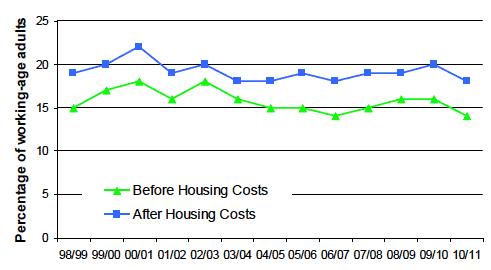
Chart 3b: Absolute Poverty: 1998/99 - 2010/11
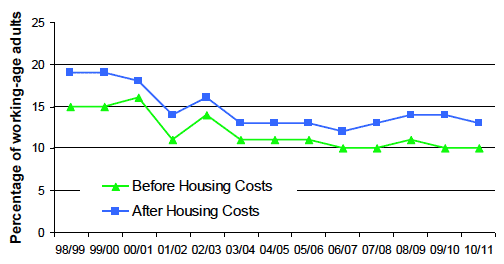
Source: HBAI dataset, DWP. These figures are also presented in Annex 1 (Tables A1 and A2).
Charts with confidence intervals for relative and absolute working age adult poverty can be found in Confidence Intervals Surrounding Key Poverty Estimates
Note that the poverty estimates for 2008/09 and 2009/10 have been revised from the previous year's publication "Poverty and income inequality in Scotland: 2009/10". This is due to a slight revision to the UK dataset due to changes in the direct tax system in Northern Ireland and new tenure data from CLG.
Main points:
- In 2010/11 the proportion of working age adults in relative poverty (BHC) dropped from 16 per cent to 14 per cent. This represents a reduction of 70,000 individuals.
- The proportion of working age adults in relative poverty (AHC) dropped from 20 per cent to 18 per cent between 2009/10 and 2010/11. This represents a reduction of 40,000 individuals.
- Factors influencing the drop in poverty observed here are outlined in Section 2.1 above.
- The proportion in absolute poverty (BHC) remained unchanged at 10 per cent, while the (AHC) figure dropped from 14 per cent to 13 per cent between 2009/10 and 2010/11.
- Since around 2003/04, working age poverty has remained fairly stable and has not shown the same extent of early decreases observed in child and pensioner poverty.
2.4 Pensioner poverty
Pensioner Material Deprivation Indicator:
This is an additional way to measure the living standards of pensioners. This measure is based on a set of goods, services and experiences, judged using academic research to be the best discriminators of deprivation. Pensioners are asked if they have an item (or access to a service) and to give a reason if they do not have it. Their responses are then used to judge whether or not they are materially deprived. It is similar to the child material deprivation and low income combined indicator which is presented in Chart 2 but has some important differences:
- Differences in the set of items asked about, e.g. pensioners are not asked if they can afford school trips.
- Pensioners are presented with a greater variety of reasons for not having a particular item, whereas families with children are simply asked whether they can afford an item they do not have. Pensioners are able to say if they are prevented from having it due to ill health, disability or lack of support from other people. These additions reflect that deprivation can occur because of ill health, disability or social isolation, and not just for financial reasons.
- The pensioner "material deprivation" indicator is not combined with household income information to produce a combined indicator, as is done with the child deprivation indicator. This is because for pensioners, the concept of material deprivation is broad and very different from low income, so it is appropriate to present it as a separate measure.
For these reasons, pensioner material deprivation cannot be directly compared to the child material deprivation and low income measure.
More background on these figures is given in Annex 2, and the following technical note on the DWP website gives further information, including the list of questions which are asked to pensioners: http://research.dwp.gov.uk/asd/hbai/technical_note_20110307.pdf
Charts 4a and 4b present recent trends for the three main pensioner poverty indicators: Relative poverty, absolute poverty and the material deprivation indicator. Note that poverty based on income after housing costs is a more commonly used measure for pensioner households as many of them have low housing costs. Further discussion on whether it is better to use before or after housing costs can be found in the Introduction.
Chart 4a: Relative poverty: 1998/99 - 2010/11
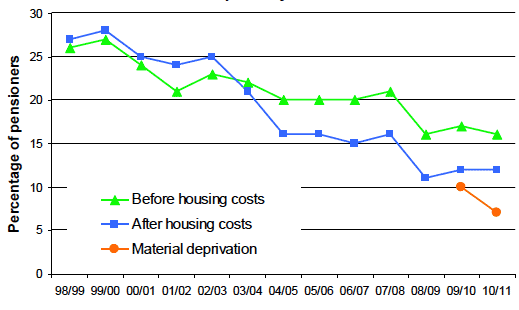
Chart 4b: Absolute poverty: 1998/99 - 2010/11
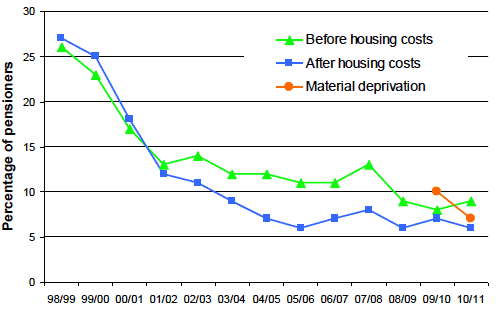
Source: HBAI dataset, DWP. These figures are also presented in Annex 1 (Tables A1 and A2 and A4).
Note: The material deprivation figure is calculated as a percentage of all over 65s whereas the relative and absolute poverty rates are calculated as a percentage of all pensioners (including women aged 60 to 65).
Charts with confidence intervals for relative and absolute pensioner poverty can be found in Confidence Intervals Surrounding Key Poverty Estimates.
Note that the poverty estimates for 2008/09 and 2009/10 have been revised from the previous year's publication "Poverty and income inequality in Scotland: 2009/10". This is due to a slight revision to the UK dataset due to changes in the direct tax system in Northern Ireland and new tenure data from CLG.
Main points:
- Pensioner relative poverty BHC decreased slightly from 17 per cent in 2010/11 to 16 per cent in 2010/11. The pensioner relative poverty measure AHC remained at 12 per cent in 2010/11.
- The changes in the latest year in the absolute pensioner poverty rates were small and not statistically significant.
- Seven per cent of over 65s were materially deprived in 2010/11, this is a decrease from 10 per cent in 2009/10.
- The fall in pensioner poverty since 1998/99 has been steeper than comparable falls for children and working age adults.
- Households containing pensioners at the lower end of the income distribution generally received a larger proportion of their income from benefits and a smaller proportion from other sources. So because benefit income grew more than earned income, households with pensioners saw their overall income fall less in real terms in 2010/11 than other households with more income from earnings. In addition, many benefits and tax credit elements were uprated in 2010/11 by 1.5 per cent or 1.8 per cent, but the Basic State Pension increased by 2.5 per cent, while Pension Credit rates increased by 2 per cent.
2.5 In-work poverty
In-work poverty:
Individuals living in households where at least one member of the household is working (either full or part time) but where the household income is below the poverty threshold. This group contains non-working household members such as children and non-working partners.
Chart 5 compares recent Scottish in-work poverty trends with the relative poverty trends.
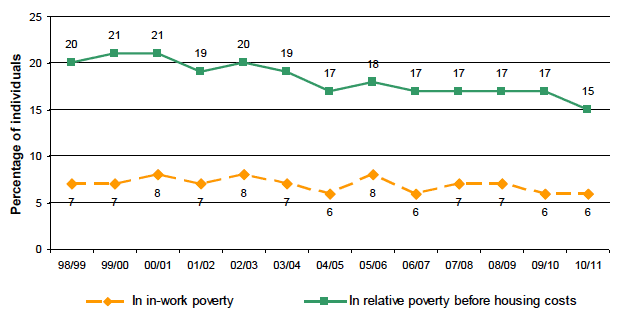
Source: HBAI dataset, DWP. These figures are also presented in Annex 1 (Table A5).
Note that the poverty estimates for 2008/09 and 2009/10 have been revised from the previous year's publication "Poverty and income inequality in Scotland: 2009/10". This is due to a slight revision to the UK dataset due to changes in the direct tax system in Northern Ireland and new tenure data from CLG.
Main points:
- During 2010/11, 6 per cent of people in Scotland were in in-work poverty. This represents 320,000 people living in households in relative poverty (BHC) despite the fact that these households contain a working member.
- In-work poverty trends have remained flat over the years since 1998/99, at between 6 and 8 per cent of the population. The latest year's figures do not show a decline in the way that many of the other poverty indicators do and this is likely to be related to the fact that earnings have gone down in real terms in 2010/11 and gone down by a greater extent in real terms when compared with income from benefits.
Contact
Email: Anne MacDonald
There is a problem
Thanks for your feedback